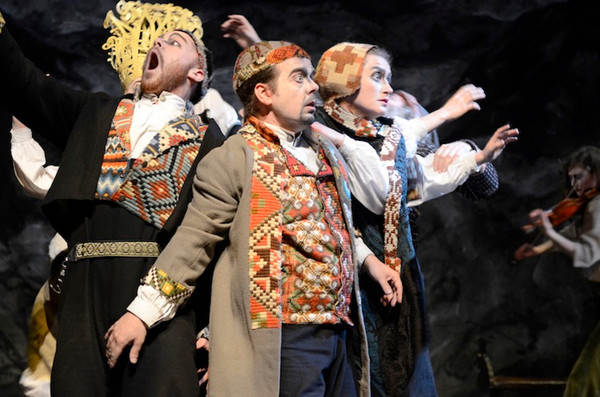
In 1859, Henrik Ibsen wrote an opera libretto – more precisely, the beginning of an opera libretto. He never finished it. It’s titled ”The Mountain Bird” (in Norwegian, “Fjeldfuglen”), and it was produced for the first time in 2009 by a Norwegian company, Grusomhetens Teater, with contemporary music by Filip Sande. The company presented the piece at La MaMa recently, in Norwegian with English surtitles. What a brilliant production! The work is based on Artaud and Grotowski, with a minimalist set and elegant, stylized acting. Its actors are masters of expressive and repeated gesture. The opera uses eight actors and only two musicians. The latter play traditional Scandinavian instruments: the fiddle, the langeleik (which is like a zither or dulcimer), a drum, the glockenspiel, and the flute. It’s a great delight to hear singers singing with next to no instrumentation, and there are choral pieces sung a capella. Ibsen’s libretto is strictly in the vein of 19th-century romanticism: The song that echoes In rushing waters There’s more to Ibsen, we see, than the social realism he’s famous for. The Mountain Bird and his verse works were written before the prose dramas. This piece of writing may be only of interest to Ibsen scholars, but Grusomhetens Teater has made it 90 minutes of excellent theater. The story is based on a medieval myth. A young girl survives the plague while everyone else in her village succumbs to it. Isolated, she becomes a child of nature, feral. Into the valley comes a party from a neighboring village. She meets one of the men and, of course, they fall in love immediately. The conflict is that our man is betrothed, and the marriage is imminent. In fact, his bride-to-be, who is in the exploration party, is already wearing her golden bridal crown. When the members of the party find that their man has fallen for the young woman, they insist that he return home with them, but, inexplicably, invite the young woman to join them. And so she does. Act Two takes place in the village of the party. It’s quite brief. The scene is a wedding celebration, and ends with the bride and groom on a sleigh, on their way to the church. At this point, the manuscript breaks off. The production is directed by Lars Øyno, very meticulously, very eloquently. Sometimes is actors move so slowly that the stage is almost a tableau vivant. “Elfin folk gladly will a-dancing go,” Ibsen tells us, and there are three graceful dancers on stage. The woman from the mountains never appears in Ibsen’s second act, but Mr. Øyno has added a song at the very end of the show from another source. Unfortunately, he’s failed to give us translation for guidance. Filip Sande’s music, in a contemporary voice, is marvelous, by turns commanding, urgent and delicate. Sande wrote it for an orchestra, but it sounds lovely as adapted for these few traditional instruments. One of the musicians plays the fiddle during the love duet, standing next to the couple as if bewitching them. The costumes are based on traditional designs, as well. They’re lovely, although not particularly colorful. The set consists of a single, small, bare tree. The splotched backdrop suggests a landscape. The production, then, has combination of aesthetics: 19th-century poetry, contemporary music, and traditional instruments and design. The result is a mesmerizing timelessness. Thanks to La MaMa for presenting this Norwegian work! It’s terrific!
The tune that rustles
Through mountain birches
